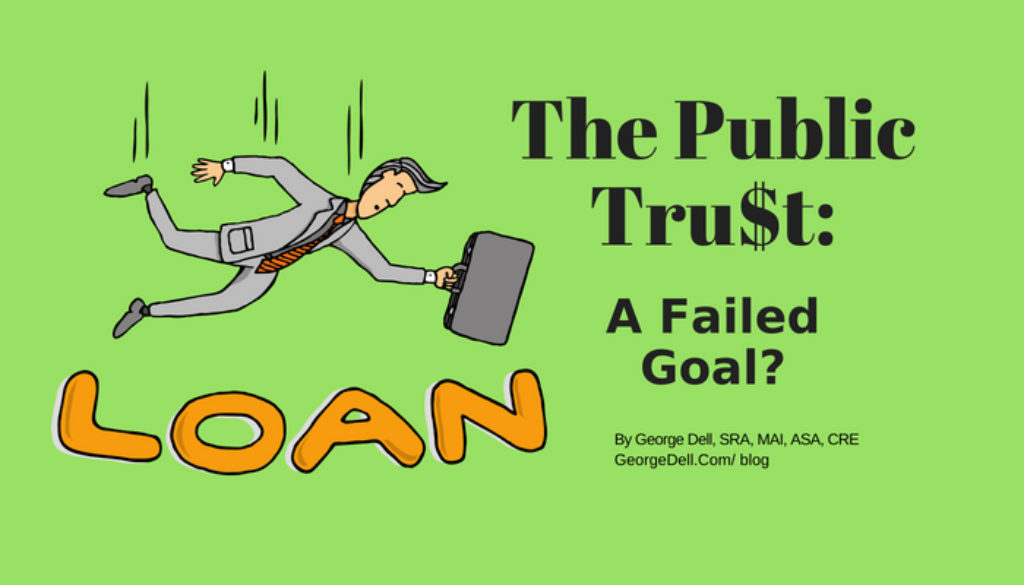Presumably, “public trust” is the foundational test. Have our institutions, rules, regulations, standards, and social expectations failed us?
The purpose of the Uniform Standards of Professional Appraisal Practice (USPAP) is to promote and maintain a high level of public trust in appraisal practice by establishing requirements for appraisers. Preamble 2018-2019
Our mission is to foster the public trust of our members and the appraisal profession through compliance with the highest levels of ethical and professional standards. The American Society of Appraisers
Its mission is to advance professionalism and ethics, global standards, methodologies, and practices through the professional development of property economics worldwide. The Appraisal Institute
Some ten years ago, financial capitalism suffered a large embarrassment. “The Great Recession.” Most people were harmed, some were ruined, losing homes, families, retirement, and opportunity for offspring. The fickle finger of cause pointed many ways. One of them was the “overexuberance” of residential lending, and the manner in which collateral was “assured.”
When things go wrong, it’s time to look at the basics: the nitty-gritty assumptions and the unanimously “acceptable” actions. Recall that the USPAP tests of appraisal acceptability only require (in short): 1) believability (credibility); 2) peers’ actions similarity, and; 3) clients’ expectations.
Valuation, in the U.S., called “appraisal” is generally subject to the Uniform Standards of Professional Appraisal Practice. Government agencies and “sponsored enterprises,” such as Fannie Mae, Freddie Mac, HUD (FHA), the VA and State regulators generally follow a specific definition of Market Value. Appraisers doing work for “federally-related purposes” are required by USPAP to “identify the type and definition of value.” If this is “market value” it must reflect “the most probable price.”
The nitty-gritty goal of appraisal is “market value.” It is exampled in USPAP Advisory Opinion AO-22. For this discussion, we can summarize into seven bullet points:
- Buyer and seller are each acting prudently and knowledgeably;
- Price is not affected by undue stimulus;
- Buyer and seller are typically motivated;
- Both parties are well informed or well advised, and acting in their own best interests;
- A reasonable time is allowed for exposure in the open market;
- Payment is in terms of cash or comparable arrangements;
- Price is normal, unaffected by special or creative financing or sales concessions.
So . . . prior to our “great recession,” what was the reality? Is it possible we were ignoring one or more of the above seven parts of “market value”?
The truth, during this time period:
- Buyer and seller are each acting speculatively with exuberance;
- Price is affected by universal euphoria;
- Buyer and seller are avariciously motivated and biased;
- Both parties are uninformed and advised by commissioned salespeople;
- Market exposure was limited or non-existent;
- Payment is in terms of cash or comparable arrangements;
- Price is enabled by unrestricted special and creative financing provided by loan “experts.”
We may consider looking further at each of these truths, and how the role of appraisers and our institutions can prevent such events in the future.
If we cannot attend to this core purpose, all else is like rearranging the deckchairs on the Titanic.

August 15, 2018 @ 4:29 am
George, Dammit, there you go again-telling the truth, especially #4! Do you have a remote control to start your car?
August 15, 2018 @ 8:22 am
Thank you Tim.
Sometimes just asking the question is more important than dictating an answer.
“Groupthink” sociology can cause more damage to the public trust — than any given individual habituated by power or greed.
August 15, 2018 @ 9:13 am
Honest words….. Thank you!
There was a day long ago where number 6 was true. That was before the depression when typical loan terms were a 5 year balloon mortgage. So most people waited until they had a half down payment and only financed the 50%. It was also typical to get only one 5 year balloon renewal, so the goal was to pay down your loan by the end of 5 or 10 years. Much closer to “cash” than current financing terms. The constant refinancing of 30 year mortgages, as has been typical during the last decade, with minimal pay off of debt, hardly equates to “cash or comparable arrangements!”
I know – we still call these creative financing terms “cash equivalent!”
August 16, 2018 @ 9:53 am
Unfortunately we have to add the appraiser into this mix. I saw a number of appraiser’s that would hit any value, for the paycheck. They did us all a disservice. I was told numerous times during this time period by Mortgage brokers, sometimes lenders that if you can’t hit the value, they will find other appraisers that will (they did). I walked away, and my business suffered greatly. I remember the “good old boys club”. preferred list of appraisers that would due whatever the Mortgage broker asked.
August 30, 2018 @ 8:23 am
George, they can’t handle the truth! nor do they want to know it. Good article but unfortunately you are speaking to the choir. I have three years left and can’t wait to get out. Not going to hang around at these fees. I have been in the business 32 years and body wants quality anymore. Nothing has changed they have just rearranged the chess pieces.